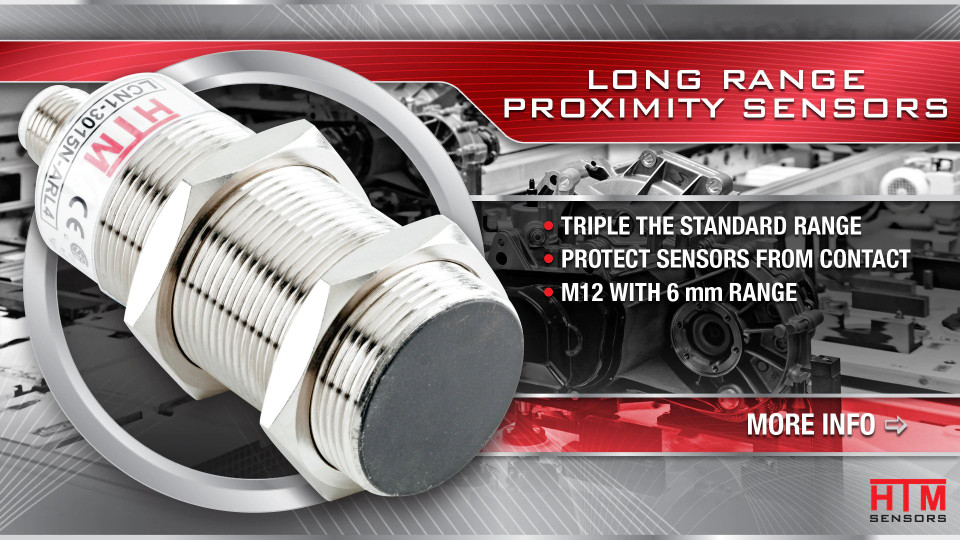Proper sensor positioning is just as crucial to process accuracy as choosing the right sensor for the process. The long range sensor is often the ideal choice for automated manufacturing processes where greater distance is required to protect the sensor. But even with the benefits of this choice, users must balance the needs for high accuracy with hysteresis. To understand why and how this affects sensor positioning, we must start with a definition of sensor hysteresis.
Hysteresis in reference to long range proximity sensors and switches is essentially about how and when the sensor turns on and off. The hysteresis of a sensor prevents it from rapidly turning on and off (chattering) if the target object is right at the operating threshold point of the sensor.
This can be a highly important factor when choosing a long-range sensor since the amount of hysteresis varies with the distance between the target and the sensor. The reason is that there is more hysteresis when the sensor is farther from the target as with a long-range distance sensor.
Potential Hysteresis Challenges with Long Range Sensor Positioning
Generally, the higher the percentage of hysteresis, the more stable the sensor is and the farther away the target must move to turn off the sensor. This clearly becomes a critical factor in optimum operation of long-range proximity sensors.
Still users will need to take hysteresis and calculations about what constitutes optimal distance into consideration when choosing and positioning a sensor. When users don’t give equal weight to these factors, they can lead to potential challenges like chatter and latching if the wrong sensor is chosen or it is positioned incorrectly.
Today’s leading manufacturers of long-range proximity sensors take hysteresis into account when designing their products to avoid the potential for what is known as chatter. This is where the sensor switches on and off rapidly close to the switching point, which negatively impacts sensor accuracy and process stability.
long-range sensor manufacturers must also take the possibility of latching into product design consideration. Latching is the process of the sensor remaining in the “on” position after the target has been removed. While chatter and latching are two potential challenges with improper sensor positioning, users must be aware of others that can also affect optimum performance.
Not all sensors are created equal so some can fall prey to several process factors that an affect accuracy due to improper positioning. One of those factors related to positioning is making sure that the mounting nuts used with long-range proximity sensors are far enough away from the sensor face. If the distance is too close, the mounting nuts can have a pre-damping effect on the sensor.
Depending on the sensor design, this close positioning to metal may be enough to hold the sensor in the “on” position (Lathing). In automated machining processes, the positioning of the sensor will be critical to avoiding this process due to metal proximity during each stage of the cycle.
Other Positioning Challenges Affecting Sensor Operation
Sensors are a standard part of automated welding and machining processes where temperatures can fluctuate widely. The choice and positioning of the sensor can have a big impact on its ability to remain stable in high temperature environments. For example, some sensors are susceptible to temperature drift, which can increase the sensor’s sensitivity to metals.
Many sensors may work correctly at the start of the process where temperatures are low but will begin operating differently and latching on as the temperature increases during the process. With many sensors rated to temperatures of around 70 ºC, users may need choices rated for temps as high as 100 ºC for stable operation.
Strong magnetic fields are common in some machining manufacturing environments where magnetic field assist processes are used to prolong tool life. In automated machining and welding processes it’s still possible to have a long-range sensor positioned in a way that the field can over saturate the coil. This leaves the sensor unable to detect that the target has been moved. By choosing weld field tolerant sensors, manufactures can avoid heat and magnetic field interference problems with sensor operation.
Proper positioning and the best choice of long-range proximity sensors are factors that carry equal weight in sensor performance in any industrial environment. Although making the right sensor choice and proper installation falls to the user, they should have support in making that determination.
it’s the sensor manufacturer’s breadth of product lines and education support that will help make that decision the right one. By choosing the right sensor manufacturer, users can get the broadest choices of long-range sensors that will yield an ideal match for every need and environment.
 Canadian Dollars
Canadian Dollars
 USD
USD

